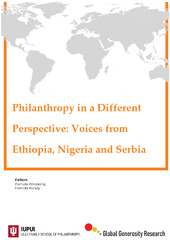Приказ основних података о документу
Civil Society Sector and Philanthropy in Serbia: Informality, Institutionalization and Changing Environment
| dc.contributor | Wiepking, Pamala | |
| dc.contributor | Handy, Femida | |
| dc.creator | Radovanović, Bojana | |
| dc.date.accessioned | 2023-10-20T09:51:18Z | |
| dc.date.available | 2023-10-20T09:51:18Z | |
| dc.date.issued | 2021 | |
| dc.identifier.isbn | 978-0-9776899-0-3 | |
| dc.identifier.uri | http://rifdt.instifdt.bg.ac.rs/123456789/3007 | |
| dc.description.abstract | Serbian citizens associate philanthropy with “helping people in need.” They believe that any kind of help, not only financial and material, is philanthropy. Accounting for the local context, the definition of philanthropy is “voluntarily dedicating one’s non-material and material resources for the benefit of others or the common good.” Thus, philanthropy includes volunteering time and donating money and possessions to formal organizations, informal groups, and individuals. Philanthropy, in some forms, has been present in Serbia since its beginnings. However, the nonprofit sector has never had a prominent role in the social welfare provision. During the socialist period spanning the second half of the 20th century, the state oversaw social welfare. Although the welfare system has moved from a socialist to a more liberal model since the beginning of the 21st century, citizens of Serbia still view the state as the essential factor in the welfare system by expanding the responsibilities of individuals and their families. The nonprofit sector is relatively young and small. Between 2001 and 2012, the legal framework for the functioning of the nonprofit sector was adopted. It was in line with European standards. Nonprofit organizations in Serbia operate through forms of associations, endowments, and foundations. A certain number of organizations are positioned for dealing with specific issues, and they have relatively well-developed capacities for advocacy and policy dialogue. In contrast, most of the nonprofits still have low advocacy and policy capacities. Strategical planning is rarely practiced, monitoring and evaluation are also weak. The sector is not homogenous when it comes to fundraising, with some organizations being professional, while others, most likely those small and are still at the embryonic phase of fundraising. The majority of nonprofit organizations face financial instability. The nonprofit sector has only fragmented relationships with the state. Governmental funding of the nonprofits is available at all three levels: central, provincial, and local. These funding opportunities are directed towards projects or programs. However, the criteria for the public financial support need to be better defined and implemented. The nonprofits are exempted from tax on grants, donations, membership dues, and non-economic sources of income. For tax benefits for donors, exemptions exist for corporate donors but not for individual donors. Additionally, the majority of Serbian citizens participate in some form of philanthropy. Informal practices are more prevalent than formal, in terms of both giving money and giving time, though the process of institutionalization of philanthropy is notable in the past couple of years. In recent years, partnerships and initiatives aiming at building a better environment for philanthropy have appeared, effects of which are still to be seen. Though the study of philanthropy as an academic discipline lacks prominence, there has been an increased interest in this research field during the past couple of years. | sr |
| dc.language.iso | en | sr |
| dc.publisher | IU Lilly Family School of Philanthropy, Indianapolis, IN | sr |
| dc.relation | "info:eu-repo/grantAgreement/MESTD/inst-2020/200025/RS//" | sr |
| dc.rights | openAccess | sr |
| dc.rights.uri | https://creativecommons.org/licenses/by/4.0/ | |
| dc.source | Philanthropy in a Different Perspective: Voices from Ethiopia, Nigeria and Serbia | sr |
| dc.subject | philanthropy | sr |
| dc.subject | global philanthropy | sr |
| dc.subject | inclusive philanthropy | sr |
| dc.subject | charity | sr |
| dc.subject | giving | sr |
| dc.subject | civil society | sr |
| dc.title | Civil Society Sector and Philanthropy in Serbia: Informality, Institutionalization and Changing Environment | sr |
| dc.type | bookPart | sr |
| dc.rights.license | BY | sr |
| dc.rights.holder | IU Lilly Family School of Philanthropy, Indianapolis, IN | sr |
| dc.citation.spage | 67 | |
| dc.citation.epage | 84 | |
| dc.type.version | publishedVersion | sr |
| dc.identifier.fulltext | http://rifdt.instifdt.bg.ac.rs/bitstream/id/10362/bitstream_10362.pdf | |
| dc.identifier.rcub | https://hdl.handle.net/21.15107/rcub_rifdt_3007 |

